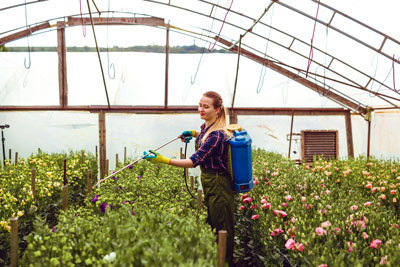4/1/2022
How to Mess Up Your Fungicide Treatments
Todd Cavins

Plants will get diseased. Here are a few things to consider so you don’t get caught with your “plants down.” The info below—along with reading, understanding and following the label instructions—can go a long way to making your fungicide applications more effective.
Not matching the action plan to the strategy: Is the strategy to prevent or rescue the plants from disease? Most plant pathologists suggest you listen to mom’s advice about an ounce of prevention (or whatever the label says) is worth a pound of cure. This is especially true if choosing biorational products. If deciding on the rescue strategy, this will likely require the costlier high end of the concentration if a range is provided. However, the bigger issue may be less saleable plants out the door.
Not getting the correct diagnosis: Did you rely on a laboratory, test strip or just the eyes for the diagnosis? There are many disease symptoms that look extremely similar regardless of pathogen. Verifying a hunch or guess with a test strip or laboratory diagnosis can be very important.
Choosing the wrong chemical: Choosing the right chemical often heavily relies on the correct diagnosis. Take a root rotter such as Pythium—it commonly requires a very different chemical than Thielaviopsis root rot. While there are some combination products that control both, they may not have the optimum concentration of the active ingredients.
Also consider how the various chemicals may work in or on the plant. Some fungicides work by contact with the pathogen versus some that enter the plant tissue and act systemically. Sometimes a contact chemical may be preferred for quick protection, but maybe it won’t provide as much long-lasting protection as a systemic product. Also, don’t forget to rotate the chemical class of fungicide you’re using.
Wrong application: Many products are labeled as both sprays and drenches. Sometimes this is to target different pathogens and sometimes it’s to provide quicker or longer-lasting protection for a given pathogen. Make sure to understand the optimum application for the given situation.
If using a contact fungicide, be sure it reaches the plant surfaces affected. Spraying the top of the leaf may not effectively control a pathogen that likes to hide on the underside.
Many products provide a concentration range, such as 8 to 12 oz. per 100 gal. If dealing with young plants or applying a product as a purely preventative measure, then the low concentration may be acceptable or needed.
Do some quick math and determine an effective way to apply consistent and uniform volume of the fungicide. Consider how much more active ingredient a plant might get if it’s lightly sprayed to a glisten versus to a heavy runoff. Same goes for drench volumes. Four versus 6 oz. of a final solution contains a very different concentration of active ingredient to a given container.
Applying fungicide to the wrong plant: Remember the statement at the top about reading the label? A critical piece of information is likely lurking somewhere in the details of the label and it may be that the chemical you’re about to use isn’t compatible with the plant in front of you. It could be that the chemical leaves a residue, burns the foliage or severely distorts the plant.
A great tool available is the electronic copy of the fungicide label. A PDF file of the label can be easily searched using your computer keyboard and “Ctrl + f” and typing in the plant name (search both the common and Latin name). Fungicide manufacturers list known or potential issues of many of the plants grown in our industry.
While most fungicides have low incidence of phytotoxicity, they still absolutely do from time to time. Trialing is encouraged. How many plants to trial? As many you’re comfortable killing.
Applying in the wrong conditions: Literally any stress can lead to confounding issues with fungicide application, be it phytotoxicity or lack of effectiveness. Thiophanate-methyl, a very common and generally safe fungicide, has been documented to cause phytotoxicity when drenched during high temperatures. The effectiveness of literally any pesticide drench can be diminished if the potting mix is too dry or too wet. Make sure the potting mix moisture is just beginning to need irrigation when applying a drench.
Not using your resources: Along with the labels, here are three excellent resources for effective fungicide applications:
• GrowerTalks Insecticide, Miticide & Fungicide Guide—growertalks.com/pdf/2022_IMF_Guide.pdf
• OHP Chemical Class Chart—ohp.com/Literature/pdf/CCC_XIII.pdf
• Ann Chase’s Frac Links Poster—chaseagri.com/frac-links-poster-order
Todd Cavins is a Technical Services Specialist for Ball Horticultural Company.